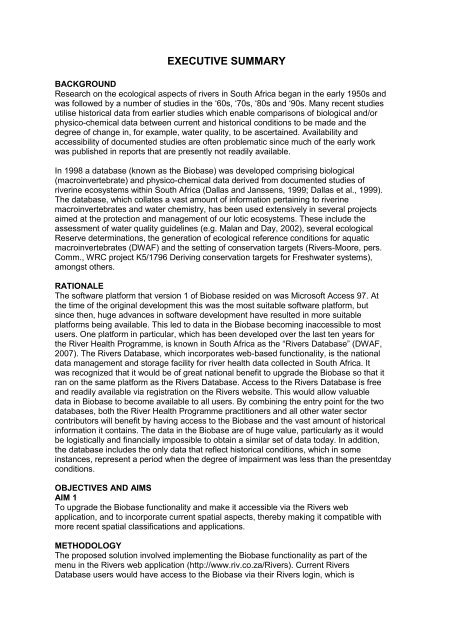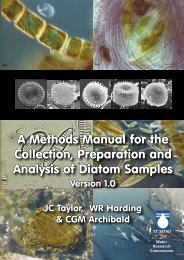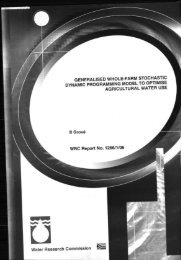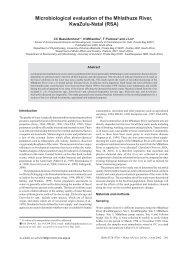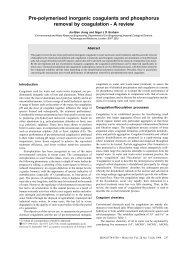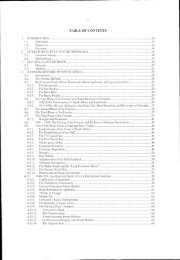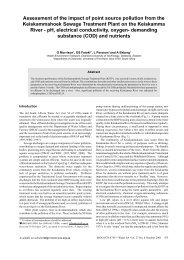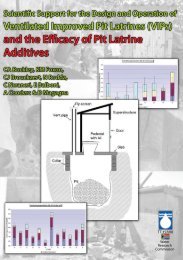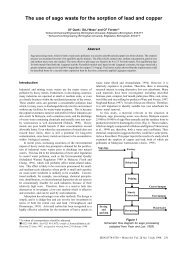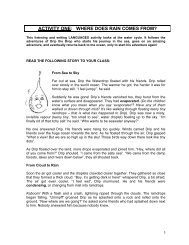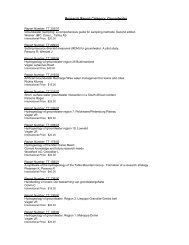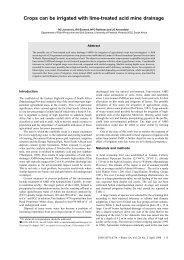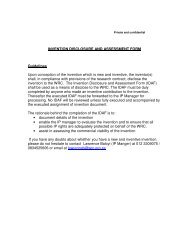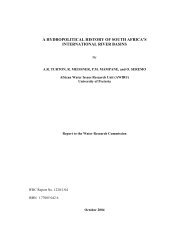EXECUTIVE SUMMARY for KV 262.pdf - Water Research Commission
EXECUTIVE SUMMARY for KV 262.pdf - Water Research Commission
EXECUTIVE SUMMARY for KV 262.pdf - Water Research Commission
Create successful ePaper yourself
Turn your PDF publications into a flip-book with our unique Google optimized e-Paper software.
<strong>EXECUTIVE</strong> <strong>SUMMARY</strong><br />
BACKGROUND<br />
<strong>Research</strong> on the ecological aspects of rivers in South Africa began in the early 1950s and<br />
was followed by a number of studies in the „60s, „70s, „80s and „90s. Many recent studies<br />
utilise historical data from earlier studies which enable comparisons of biological and/or<br />
physico-chemical data between current and historical conditions to be made and the<br />
degree of change in, <strong>for</strong> example, water quality, to be ascertained. Availability and<br />
accessibility of documented studies are often problematic since much of the early work<br />
was published in reports that are presently not readily available.<br />
In 1998 a database (known as the Biobase) was developed comprising biological<br />
(macroinvertebrate) and physico-chemical data derived from documented studies of<br />
riverine ecosystems within South Africa (Dallas and Janssens, 1999; Dallas et al., 1999).<br />
The database, which collates a vast amount of in<strong>for</strong>mation pertaining to riverine<br />
macroinvertebrates and water chemistry, has been used extensively in several projects<br />
aimed at the protection and management of our lotic ecosystems. These include the<br />
assessment of water quality guidelines (e.g. Malan and Day, 2002), several ecological<br />
Reserve determinations, the generation of ecological reference conditions <strong>for</strong> aquatic<br />
macroinvertebrates (DWAF) and the setting of conservation targets (Rivers-Moore, pers.<br />
Comm., WRC project K5/1796 Deriving conservation targets <strong>for</strong> Freshwater systems),<br />
amongst others.<br />
RATIONALE<br />
The software plat<strong>for</strong>m that version 1 of Biobase resided on was Microsoft Access 97. At<br />
the time of the original development this was the most suitable software plat<strong>for</strong>m, but<br />
since then, huge advances in software development have resulted in more suitable<br />
plat<strong>for</strong>ms being available. This led to data in the Biobase becoming inaccessible to most<br />
users. One plat<strong>for</strong>m in particular, which has been developed over the last ten years <strong>for</strong><br />
the River Health Programme, is known in South Africa as the “Rivers Database” (DWAF,<br />
2007). The Rivers Database, which incorporates web-based functionality, is the national<br />
data management and storage facility <strong>for</strong> river health data collected in South Africa. It<br />
was recognized that it would be of great national benefit to upgrade the Biobase so that it<br />
ran on the same plat<strong>for</strong>m as the Rivers Database. Access to the Rivers Database is free<br />
and readily available via registration on the Rivers website. This would allow valuable<br />
data in Biobase to become available to all users. By combining the entry point <strong>for</strong> the two<br />
databases, both the River Health Programme practitioners and all other water sector<br />
contributors will benefit by having access to the Biobase and the vast amount of historical<br />
in<strong>for</strong>mation it contains. The data in the Biobase are of huge value, particularly as it would<br />
be logistically and financially impossible to obtain a similar set of data today. In addition,<br />
the database includes the only data that reflect historical conditions, which in some<br />
instances, represent a period when the degree of impairment was less than the presentday<br />
conditions.<br />
OBJECTIVES AND AIMS<br />
AIM 1<br />
To upgrade the Biobase functionality and make it accessible via the Rivers web<br />
application, and to incorporate current spatial aspects, thereby making it compatible with<br />
more recent spatial classifications and applications.<br />
METHODOLOGY<br />
The proposed solution involved implementing the Biobase functionality as part of the<br />
menu in the Rivers web application (http://www.riv.co.za/Rivers). Current Rivers<br />
Database users would have access to the Biobase via their Rivers login, which is
controlled by the Rivers Administrator. Integration of Biobase data with Rivers Database<br />
data occurs at river level where the Biobase would use the existing River entities. All<br />
other entities (Site, biotope, macroinvertebrate and physico-chemical data, etc.) are<br />
managed separately. Functionality has been replicated as closely as possible on the web,<br />
with the exception of the query capability. Current query and pivoting functionality has<br />
been replaced by the query master and new QM queries have been created as required.<br />
The tasks undertaken included:<br />
Creation of the database (upgrade to SQL, design and build tables, import and<br />
convert data, match rivers)<br />
Generation of application infrastructure (setting up object model)<br />
Development of complex <strong>for</strong>ms (spatial frameworks, site search, site detail,<br />
biological and chemical link, biotopes and taxon management, chemistry,<br />
taxonomy, references, pick lists, data list views)<br />
Development of the Query master (reports and data export)<br />
Implementation (testing, implementation on web and issue management)<br />
Development of a user manual<br />
Soft Craft Systems have undertaken the redesign of the application, while The<br />
Freshwater Consulting Group (FCG) has assisted with the design, validation and spatial<br />
aspects. FCG has produced the user guide, in collaboration with Soft Craft Systems, <strong>for</strong><br />
publication by the WRC. This report is the User Manual.<br />
RESULTS AND DISCUSSION<br />
Detailed in<strong>for</strong>mation on viewing and querying data in the Biobase has been provided,<br />
together with screen dumps of the actual database. These include the four key viewing<br />
components, namely Sites, Biological & Physico-Chemical Data, Taxonomic Data, and<br />
Study Reference In<strong>for</strong>mation. The Query Master is described and steps <strong>for</strong> extracting<br />
data listed. The utility and limitations of the database have been discussed. These<br />
include, amongst others, deducing ranges of different physico-chemical parameters, <strong>for</strong><br />
different taxa; assessing changes in community structure, using historical records;<br />
examining biotope preferences of specific taxa; assessment of water quality guidelines<br />
and input into the ecological Reserve; determination of macroinvertebrate reference<br />
conditions; development of conservation targets; and determination of the geographic<br />
distribution of taxa.<br />
CONCLUSIONS<br />
The database, which collates a vast amount of in<strong>for</strong>mation pertaining to riverine<br />
macroinvertebrates and water chemistry, has several useful applications if used with the<br />
awareness of the problems outlined in this report. In establishing this database, one of<br />
the problems encountered, that was both difficult to resolve and avoidable, was that<br />
caused by the lack of consistency in the way in which different authors present their data.<br />
Frequently, useful data are lost, merely because they cannot be compared with others.<br />
The data captured in the Biobase include most of the biological data on<br />
macroinvertebrates prior to 1998. Since then numerous studies have been undertaken<br />
and a wealth of data exists. It would be highly advantageous to incorporate these data<br />
into the Biobase.<br />
RECOMMENDATIONS FOR FUTURE RESEARCH<br />
One of the more important recommendations to emerge from this area of work is that<br />
future biological and chemical collections should con<strong>for</strong>m to the standard units of<br />
physicochemical measurements as described in this User Manual and that <strong>for</strong> biological data<br />
details of proportional abundance, as well as factors such as biotope type, should be<br />
provided. In addition, the actual dates on which both biological and physico-chemical data<br />
were collected should be available <strong>for</strong> reference, where they are not actually presented in
published reports. Preferably an electronic copy of all data in its original <strong>for</strong>m should be<br />
lodged with a responsible organisation such as the <strong>Water</strong> research <strong>Commission</strong>. It is<br />
recommended that funding be sought to enable data from studies undertaken after 1998,<br />
as well as those prior to 1998 that are not yet in the Biobase, to be captured into the<br />
Biobase.


